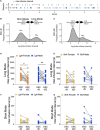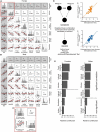Ranking the contribution of behavioral measures comprising oxycodone self-administration to reinstatement of drug-seeking in male and female rats
- PMID: 36505730
- PMCID: PMC9731098
- DOI: 10.3389/fnbeh.2022.1035350
Ranking the contribution of behavioral measures comprising oxycodone self-administration to reinstatement of drug-seeking in male and female rats
Abstract
Introduction: Rates of relapse to drug use during abstinence are among the highest for opioid use disorder (OUD). In preclinical studies, reinstatement to drug-seeking has been extensively studied as a model of relapse-but the work has been primarily in males. We asked whether biological sex contributes to behaviors comprising self-administration of the prescription opioid oxycodone in rats, and we calculated the relative contribution of these behavioral measures to reinstatement in male and female rats.
Materials and methods: Rats were trained to self-administer oxycodone (8 days, training phase), after which we examined oxycodone self-administration behaviors for an additional 14 days under three conditions in male and female rats: short access (ShA, 1 h/d), long access (LgA, 6 h/d), and saline self-administration. All rats were then tested for cue-induced reinstatement of drug-seeking after a 14-d forced abstinence period. We quantified the # of infusions, front-loading of drug intake, non-reinforced lever pressing, inter-infusion intervals, escalation of intake, and reinstatement responding on the active lever.
Results: Both male and female rats in LgA and ShA conditions escalated oxycodone intake to a similar extent. However, males had higher levels of non-reinforced responding than females under LgA conditions, and females had greater levels of reinstatement responding than males. We then correlated each addiction-related measure listed above with reinstatement responding in males and females and ranked their respective relative contributions. Although the majority of behavioral measures associated with oxycodone self-administration did not show sex differences on their own, when analyzed together using partial least squares regression, their relative contributions to reinstatement were sex-dependent. Front-loading behavior was calculated to have the highest relative contribution to reinstatement in both sexes, with long and short inter-infusion intervals having the second greatest contribution in females and males, respectively.
Discussion: Our results demonstrate sex differences in some oxycodone self-administration measures. More importantly, we demonstrate that a sex- dependent constellation of self-administration behaviors can predict the magnitude of reinstatement, which holds great promise for relapse prevention in people.
Keywords: escalation; female; front-loading; opioid; relapse; sex difference; vulnerability.
Copyright © 2022 Guha, Alonso-Caraballo, Driscoll, Babb, Neal, Constantino, Lintz, Kinard and Chartoff.
Conflict of interest statement
The authors declare that the research was conducted in the absence of any commercial or financial relationships that could be construed as a potential conflict of interest.
Figures








References
-
- American Psychiatric Association (2013). Diagnostic and statistical manual of mental disorders. Washington, DC: American Psychiatric Association.
Grants and funding
LinkOut - more resources
Full Text Sources

